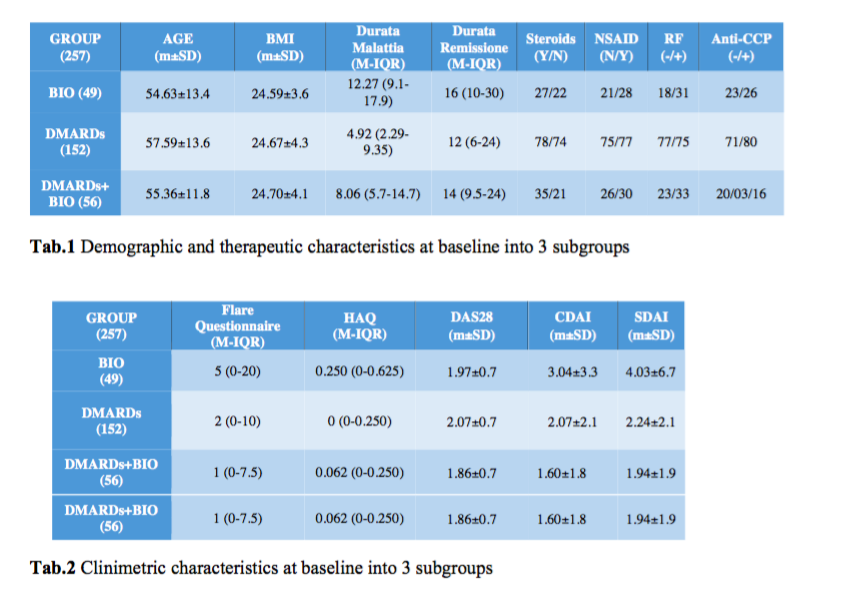Session Information
Date: Sunday, November 13, 2016
Title: Imaging of Rheumatic Diseases - Poster I: Ultrasound and Emerging Technologies
Session Type: ACR Poster Session A
Session Time: 9:00AM-11:00AM
Methods
: STARTER is a multicentre cohort study promoted by the Musculoskeletal Ultrasound Study Group of SIR that includes 25 Italian rheumatology units. 427 consecutive patients with a diagnosis of RA according to the American College of Rheumatology (ACR) criteria 1987 or ACR/EULAR (European League Against Rheumatism) 2010 criteria and in clinical remission were recruited between October 2013 and June 2014; at baseline (T0), 6 (T1) and 12 (T2) months each patient was undergoing clinical evaluation (performed by rheumatologists blinded to the ultrasound data) and ultrasound by using a semi-quantitative score 0-3 gray scale (GS) and power doppler (PD) for the evaluation of the flexor and extensor tendons of the fingers and wrists. For each patient it was calculated a final score of GS-tenosynovitis, PD-tenosynovitis. The ultrasound remission was defined as a score = 0. Were included in the study 427 patients, divided into 3 subgroups according to background therapy at baseline: patients with biologic in monotherapy (BIO), patients with DMARD in monotherapy (DMARDs), patients in combo therapy (DMARDs + BIO).Results
: 257 patients completed the observation period. 49 pts in BIO group (19.7%, F34 / M15), 152 pts in the DMARDs group (59.14% -F105 / M47), 56 pts in BIO + DMARDs group (21.79% -F47 / M9). The demographic and clinical characteristics at baseline are presented in Table 1 and 2. At baseline, 56.03% (144/257) of patients showed tenosynovitis, the 48.98% (24/49) BIO, the 57.89% (88/152) DMARDs, the 57.14% (32/56) DMARDs + BIO. The tenosynovitis involvement at baseline, at 6 and 12 months showed into three different subgroups analyzed, has no statistically significant changes (Fig. A). In the BIO group, there was a patient who had a flare few days prior to follow up visit at T12.Conclusion
: As shown in STARTER study, the prevalence of subclinical tenosynovitis is relevant in the subpopulation of patients with RA in clinical remission. The analysis into subgroups, based on the therapy performed, although it did not show any significant differences, demonstrated a trend to a lower prevalence of inflammatory manifestations of the tendons of the hands and wrists in favor of patients with combo therapy (DMARDs + BIO ) than patients with only DMARDs o Biological in monotherapy. These results could indicate a higher probability to getting better outcomes in patients treated by combo therapy.|
GROUP (257) |
AGE (m±SD) |
BMI (m±SD) |
Durata Malattia (M-IQR) |
Durata Remissione (M-IQR) |
Steroids (Y/N) |
NSAID (N/Y) |
RF (-/+) |
Anti-CCP (-/+) |
|
BIO (49) |
54.63±13.4 |
24.59±3.6 |
12.27 (9.1-17.9) |
16 (10-30) |
27/22 |
21/28 |
18/31 |
23/26 |
|
DMARDs (152) |
57.59±13.6 |
24.67±4.3 |
4.92 (2.29-9.35) |
12 (6-24) |
78/74 |
75/77 |
77/75 |
71/80 |
|
DMARDs+BIO (56) |
55.36±11.8 |
24.70±4.1 |
8.06 (5.7-14.7) |
14 (9.5-24) |
35/21 |
26/30 |
23/33 |
20/03/16 |
|
GROUP (257) |
Flare Questionnaire (M-IQR) |
HAQ (M-IQR) |
DAS28 (m±SD) |
CDAI (m±SD) |
SDAI (m±SD) |
|
BIO (49) |
5 (0-20) |
0.250 (0-0.625) |
1.97±0.7 |
3.04±3.3 |
4.03±6.7 |
|
DMARDs (152) |
2 (0-10) |
0 (0-0.250) |
2.07±0.7 |
2.07±2.1 |
2.24±2.1 |
|
DMARDs+BIO (56) |
1 (0-7.5) |
0.062 (0-0.250) |
1.86±0.7 |
1.60±1.8 |
1.94±1.9 |
|
DMARDs+BIO (56) |
1 (0-7.5) |
0.062 (0-0.250) |
1.86±0.7 |
1.60±1.8 |
1.94±1.9 |
Tab.1 Demographic and therapeutic characteristics at baseline into 3 subgroups Tab.2 Clinimetric characteristics at baseline into 3 subgroups
|
Tenosynovitis |
Fig.A
To cite this abstract in AMA style:
Parisi S, Carrara G, Scirè CA, Batticciotto A, Bellis E, Canzoni M, De Lucia O, Farina I, Venditti C, Iagnocco A, Filippou G. Relationship Between the Prevalence of Subclinical Tenosynovitis and Therapy in Patients with RA in Clinical Remission: Results from Italian Society of Rheumatology Study Group [abstract]. Arthritis Rheumatol. 2016; 68 (suppl 10). https://acrabstracts.org/abstract/relationship-between-the-prevalence-of-subclinical-tenosynovitis-and-therapy-in-patients-with-ra-in-clinical-remission-results-from-italian-society-of-rheumatology-study-group/. Accessed .« Back to 2016 ACR/ARHP Annual Meeting
ACR Meeting Abstracts - https://acrabstracts.org/abstract/relationship-between-the-prevalence-of-subclinical-tenosynovitis-and-therapy-in-patients-with-ra-in-clinical-remission-results-from-italian-society-of-rheumatology-study-group/


